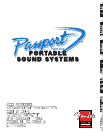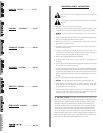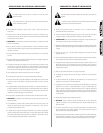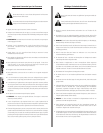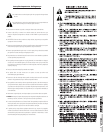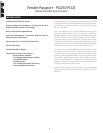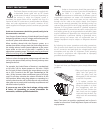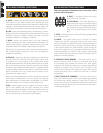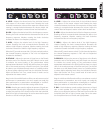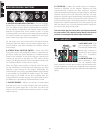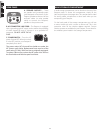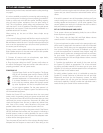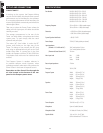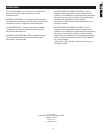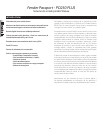
9
A. LEVEL Adjusts the volume level of the individual channel
with respect to the master volume level. Rotating the knob
clockwise increases the volume of the respective channel, while
rotating it counterclockwise decreases the volume. Adjust this
control after the Passport’s master volume level has been set.
B. LOW – Adjusts the relative level of the low frequency content.
Rotating the knob counterclockwise decreases the bass or low
frequency response. Likewise, rotating the knob clockwise
increases the bass or low frequency response.
C. HIGH – Adjusts the relative level of the high frequency
content. Rotating the knob counterclockwise decreases the
treble or high frequency response. Likewise, rotating the knob
clockwise increases the treble or high frequency response.
When the EQ controls are set at their 12 o'clock notched position,
the channel frequency response is “flat” with no frequencies
increased or decreased.
D. REV/AUX Adjusts the amount of signal sent to the Reverb
processor, and to the Rev/Aux send jack. Reverb can be used
to enhance the sound quality of any performance where
appropriate and desired. In the full left position there is no signal
sent to the reverb processor or Rev/Aux send jack. Care should
be taken to set the Master Reverb control to a middle position
or above, before adjusting levels from the individual channels.
When the Rev/Aux mix is set, overall levels of reverb can be
adjusted at the master control.
Keep in mind that while Reverb or effects can enhance a musical
performance or presentation, too much reverb can make the
same performance or presentation unintelligible or “muffled”.
Keep your audience in mind when setting reverb levels.
E. PAN – Use the pan control to adjust the amount of signal sent
to each speaker (left and right). Adjusting this control allows you
to adjust the position of the sound source within the horizontal
plane, left or right of center stage. Set to the center dot for equal
amounts to the left and right speakers.
A. LEVEL Adjusts the volume level of the individual channel
with respect to the master volume level. Rotating the knob
clockwise increases the volume of the respective channel, while
rotating it counterclockwise decreases the volume. Adjust this
control after the Passport’s master volume level has been set.
B. LOW – Adjusts the relative level of the low frequency content.
Rotating the knob counterclockwise decreases the bass or low
frequency response. Likewise, rotating the knob clockwise
increases the bass or low frequency response.
C. HIGH – Adjusts the relative level of the high frequency
content. Rotating the knob counterclockwise decreases the
treble or high frequency response. Likewise, rotating the knob
clockwise increases the treble or high frequency response.
When the EQ controls are set at their 12 o'clock notched position,
the channel frequency response is “flat” with no frequencies
increased or decreased.
D. REV/AUX Adjusts the amount of signal sent to the Reverb
processor, and to the Rev/Aux send jack. Reverb can be used
to enhance the sound quality of any performance where
appropriate and desired. In the full left position there is no signal
sent to the reverb processor or Rev/Aux send jack. Care should
be taken to set the Master Reverb control to a middle position
or above, before adjusting levels from the individual channels.
When the Rev/Aux mix is set, overall levels of reverb can be
adjusted at the master control.
Keep in mind that while Reverb or effects can enhance a musical
performance or presentation, too much reverb can make the
same performance or presentation unintelligible or “muffled”.
Keep your audience in mind when setting reverb levels.
E. BAL – Use the balance control to adjust the amount of signal
sent to each speaker (left and right). Adjusting this control
allows you to adjust the position of the sound source within the
horizontal plane, left or right of center stage. Set to the center
dot for equal amounts to the left and right speakers.
MoNo MIc / lINe coNtrol fuNctIoNS Stereo coNtrol fuNctIoNS



